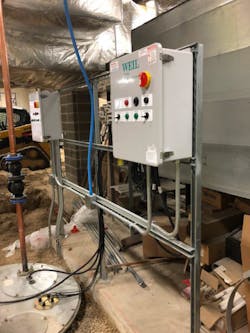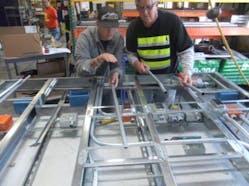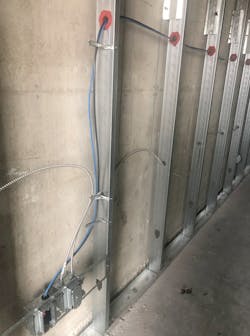Whether you’re building small residential homes, or large, towering high-rise commercial buildings, chances are you’re doing the branch circuit wiring and the device installation as well as the larger elements. We’ve all heard the euphemism “don’t sweat the small stuff,” but it doesn’t apply to branch circuit work in electrical construction.
If you use cost codes, you can see how much of your work is in branch circuit wiring. For many contractors, it is north of 25%. Yet, most tend to give branch circuit work to the lowest guy/gal on the totem pole. The expectation is that the harder, more challenging tasks that require more skill and experience should be left to the most tenured electricians with the most experience and skill. Often these highest-paid electricians have earned the right to do their own thinking and use their own creativity and ingenuity to solve problems on the fly. This article explains why small stuff matters and adds to your job-site intelligence arsenal of questions/things to look for on your next job-site visit.
Decision making and skill level
As construction continues to evolve toward industrialization, amidst an irreversible workforce shortage, we must find ways to get the most “bang for the buck.” How often can you make up the losses on branch circuit work by gaining huge efficiency on feeder circuits? How often can you make up losses on devices and device terminations with productivity gains on luminaires or underground work? If you’re like most contractors, the answer is, not very often. But why not? Why can’t matching the skill set and experience of the installer with the work required guarantee you’ll make as much profit as possible? There are two reasons this doesn’t just happen.
First, all work requires decisions. Who makes those decisions (and when the decisions get made) are critical components to the outcome of any task. MCA, Inc.’s Industrialization Litmus test (based on MCA’s 2020 research report, “Industrialization of Construction: Signal or Noise? Threat or Promise?” with ELECTRI International) shows that 80% to 90% of the decisions about manpower, material, tools, and information are made by individual electricians. When these decisions are allowed to be made at the point of installation, highly skilled and experienced field supervisors (e.g., crew leads, foremen, general foreman) are still required to ensure a satisfactory outcome. If the highly skilled decision-makers are only looking at 10% to 15% of the total work on the project, the other 85% to 90% is left in the hands of the least qualified decision-makers. Regardless of whether you break it down with hours, dollars, or headcount, the results are the same; there typically just isn’t enough of that complex highly skilled work to overcome losses in the lesser skilled work.
Second, the lesser-skilled workers are still less productive on the simpler tasks because they haven’t done them enough to be good at them. The same model that allows the skilled worker the decision-making authority on the challenging tasks also allows the lesser skilled worker to have decision-making authority on their assigned tasks. This doesn’t imply that the lesser-skilled worker makes bad decisions, only that with less experience they take more time to make the decisions, and this time spent planning “on the fly” degrades productivity. For this very reason, an experienced skilled worker can perform simple tasks far more productively than a lesser skilled worker.
Here are a few things you can expect to see (and should look for) when not “sweating the small stuff.”
Overbuilding
If you’re still able to walk the job and see exposed rough-in, look at what was required for the installation compared to what was done. Do you see any of the following:
- Unnecessary bends
- Unnecessary conduit routing
- Use of additional boxes or junctions boxes
- Unnecessary supports
- If you do both electrical and technology work, rough-in work being done for multiple systems (e.g., branch wire for power and low-voltage cabling) in the same space
- Oversized conduit for the application
- Unnecessary (and more expensive) materials used than what is specified (e.g., installing EMT when the spec permitted MC cable)
- Work being performed that is not part of the scope — either knowingly helping other trades or not understanding the details of the contract (see Photo 1 below)
Recognizing overbuilding before it occurs is difficult and requires planning by someone who has experience that includes various means and methods. Even though branch circuit work is physically “small,” the decisions made at the layout phase can reduce overbuilding by understanding the specs and requirements, which are often not part of the newer electrician’s experience.
Missed prefab opportunities
Prefab planning requires prefab thinking, which results from prior experience with prefabricated assemblies and their installation (see Photo 2 below). The branch circuit lends itself well to prefabrication; however, this needs to be brought to the lesser-experienced worker by management and supervision. Prefab thinking starts with leadership and is best translated through training and reference materials, such as the checklist below for identifying branch opportunities.
- Kitting by location (both components and hardware)
- Labeling by kit and location
- Color-coding to reduce identification errors
- Assembly and component labeling to reduce installation errors
- Tools as needed for installation on location with the kits
- Common boxes, knockouts, and mounting brackets
- Pre-attached connectors and ground terminals
- Common mud rings
- Pigtailed devices and common connectors
- Offsets and 90s (pre-shaped) and cut to length
- Racks, trays, and trapeze assemblies
- Multiple conduits pre-mounted on common rack assemblies
- Pre-configured and pre-tested programmable devices
- Returns and clean off containers
- VMI to include delivery and material movement
Wasted time due to poor layout
Branch circuit work is where a significant amount of your field labor’s time is spent; therefore the activities below will all be impacted by how branch circuit work is laid out (or not):
- Getting material to and from the installation location
- Having the right tools, material, and information available to do the work
- Movements/motion to get to the workspace, which could also impact safety risk
- Ease of testing and troubleshooting after installation is complete
- Quality (including avoiding rework) to the spec and the Code
One of the biggest cost events associated with weak or inexperienced planners is rework or extra work (see Photo 3 below). Running wires around other trades or where they need to be redone is prevalent with inexperienced planners. Not taking the time to fully visualize the completed project will lead to incomplete or ineffective coordination. Missing early coordination opportunities is a common root cause of poor layout, especially on BIM-coordinated projects.
Even though this discussion may simply reiterate observations that you’ve made throughout your career, how do you know what to do about it? It’s not best to simply use all highly skilled workers, at a much higher wage, the needed productivity comes from the experience with the decisions.
Work that is repetitious or minimally unique can be planned in advance. Planning for branch circuit installation should be done during the job start-up, kick-off, and development of the initial work breakdown structure of the job. Procurement, prefabrication, and installation are all planned before assemblies are designed and drawn in BIM (before components are ordered and shipped to the job site and before work is assigned). Making the biggest portions of the work the most well-planned and executed installations is the key.
Planning is the first thing, but it isn’t everything. A productive installation also requires management support. Management in the form of detecting issues and anomalies early enough to send help and correct the problems before they become irreversible. Tools like short-interval scheduling can tell us when we can afford to let the simple stuff go. Oversight and visibility of the plan and the daily progress is the best way to allow the lesser-skilled workers to gain experience without repeating mistakes and retain the learning already achieved by others. By efficiently bringing visibility to the little things and with proper planning, you can align the installation skillset with the work difficulty and minimize project labor costs/overruns.
Phil Nimmo is vice president of business development at MCA, Inc., Grand Blanc, Mich. He can be reached at [email protected] Dr. Heather Moore is vice president of customer care and support at MCA, Inc. She can be reached at [email protected].






